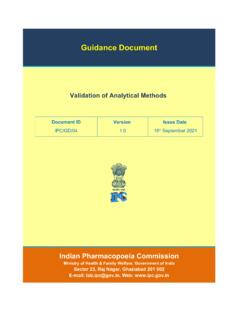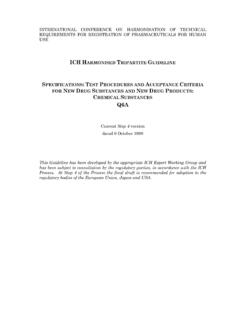Transcription of Validation of Analytical Methods
1 Guidance DocumentValidation of Analytical Methods Document IDIPC/GD/04 Version Date 16th September 2021 Indian Pharmacopoeia CommissionMinistry of Health & Family Welfare, Government of IndiaSector 23, Raj Nagar, Ghaziabad 201 002E-mail: Web: | 2 DisclaimerThis Guidance Document is compiled by the Indian Pharmacopoeia Commission (IPC) after consultations with the Core Expert Committee constituted by the IPC for this purpose. The information contained herein represents the current best practices in the field of pharmacopoeial sciences to demonstrate compliance with the existing regulatory requirements. The guidance provided in this document is not intended to alter or modify or supplement or in any other way change the contents of the Indian Pharmacopoeia (IP), but is intended to provide general guidance to all users of the IP to help in ensuring proper compliance with the IP requirements when standards of drugs are to be determined.
2 The content of this document shall be treated as non-mandatory guidance and the information contained herein is subject to review by the IPC. Approaches and Methods other than those described in this Guidance Document may be adopted if found suitable and justified. Where provisions of the law exist, the law as prevailing at the relevant time shall | 3 IntroductionMethod Validation is the process by which it is demonstrated through documentary evidence that the performance characteristics of the method meet the requirements for the intended application. All the Analytical Methods that are intended for analyzing any sample need to be validated. The suitability of all test Methods used should always be verified under the actual conditions of use and should be well ProcessA well planned process should be followed during Validation .
3 Possible steps for a complete method Validation are listed a Validation ProtocolThe first step in method Validation is to prepare a written and approved protocol with the instructions in a clear step-by-step format. Following is a step-by-step guide for preparing protocols and performing test Methods Validation with reference to HPLC. One may use similar criteria for all other instrumental test method Validation . Typical method Validation protocol should include: Introduction: Firms Validation policy, general description Organizational structure: Description of all personal responsibilities for all Validation activities Process and product description:Makes a brief description of the process and product or reference to adequate documents Specific process considerations: describes critical characteristics of the process Key acceptance criteria : General statement on acceptance criteria for the process Documentation format: The format used for protocol and report is described Required SOPs: a list of relevant SOPs should be mentioned Planning and Scheduling: describes the resources, equipments and chemicals to be used, including time plan of the project Change control.
4 Includes description or reference to the critical parameters variations in the process or productAnalytical Method Validation Protocol-Cover PageSummary InformationSummary InformationOrganization NameSite LocationDepartment Performing ValidationProtocol TitleValidation NumberEquipmentRevision NumberProject ControllerProject ControllerNameSignatureDatePage | 4 Document ApprovalDocument ApprovalDepartment / Functional AreaNameSignatureDateTechnical ReviewerEnd Lab ManagementHealth & SafetyQuality AssuranceDocumentation Control(reviewed and archived by) ParametersThe Analytical Methods which need to be validated are as following: Identification tests: To ensure identity of an analyte Quantitative test for impurities: to accurately and quantitatively reflect the purity of a sample Limit test for impurities: to reflect purity characteristics of the sample Assay of drug substance and drug products: to measure accurately and quantitatively the analyte present in the sample.
5 These Methods also include analysis for content uniformity and measurement of analyte from dissolution samplesThe characteristics which need to be validated for the different types of method are summarized in following CharacteristicsAssayTesting for ImpuritiesIdentificationQuantitativeLimi tAccuracyYesYesNoNoPrecision-Repeatabili tyYesYesNoNoPrecision-Intermediate PrecisionYesYesNoNoSpecificityYesYesYesY esDetection LimitNoNoYesNoQuantitation performance Characteristics(i)SpecificitySpecificity (or selectivity) of the Analytical method is defined as the ability to assess unequivocally the analyte in the presence of other compounds (such as impurities, degradants, matrix, etc.) that are likely to be present. Specificity study of the chromatographic method is performed by the separation of the analyte from the other potential components such as impurities, degradants or excipients etc.
6 The selectivity of chromatographic Methods may be assessed by examination of peak homogeneity or peak purity test. Peak purity test shows that there is no co-elution of any sample component. For this, peak purity assessment is done by Page | 5 using PDA or MS detectors. Representative chromatograms with peaks labeled should be included with resolution, plate count and tailing factor reported in the Validation report. Test procedure The specificity of the assay method will be investigated by injecting of the extracted placebo to demonstrate the absence of interference with the elution of analyte. Documentation Print chromatograms. Acceptance criteria The excipient compounds must not interfere with the analysis of the targeted analyte.(ii)LinearityLinearity of a method is its ability to obtain test results that are directly proportional to the sample concentration over a given range.
7 For HPLC Methods , the linear relationship between detector response (peak area and height) and sample concentration is determined. The relationship can be demonstrated directly on drug substance by dilution of standard stock or by separate weighing of the sample components, using the proposed should be evaluated by visual inspection of a plot of signals as a function of analyte concentration or content. If there is linear relationship, test results should be evaluated by appropriate statistical Methods , for example, by regression analysis. Data from the regression line is helpful to provide mathematical estimates of the degree of linearity. It is generally expressed in terms of variance around the slope of regression line. In some cases, the Analytical responses should be described by the appropriate function of the analyte concentration.
8 The widely used linearity ranges and acceptance criteria for various pharmaceutical Methods are listed in following Levels and RangesAcceptance CriteriaAssayFive levels,50-150% of label claimCorrelation coefficient,R to eight levels,10-150% of label claim% y intercept NMT ; R SubstancesFive levels,LOQ to acceptance criteria % y intercept NMT , R Test procedure Standard solutions will be prepared at six concentrations, typically 25, 50, 75, 100, 150, and 200% of target concentration. Three individually prepared replicates at each concentration will be analyzed. The method of standard preparation and the number of injections will be same as used in the final procedure. Documentation Record results on a datasheet. Calculate the mean, standard deviation, and RSD for each concentration.
9 Plot concentration (x-axis) versus mean response (y-axis) for eachconcentration. Calculate the regression equation and coefficient of determination (r2). Record these calculations on the datasheet. Acceptance criteria The correlation coefficient for six concentration levels will be for the range of 80% to 120% of the target concentration. The y-intercept must be 2% of the target concentration response. A plot of response factor versus concentration must show all values within of the target level response factor, for concentrations between 80% and 120% of the target Page | 6 concentration. In general, the coefficient of determination for active ingredients should be , for impurities and for biologics Data SheetLinearity Data SheetElectronic File Name:Concentration(mg/ml)Concentration as % of Analyte TargetPeak Area (mean of three injections)Peak Area RSD (%)5 ( )2510501575201003015040200(iii)RangeRang e of an Analytical method is the interval between the upper and lower concentration of analyte in the sample (including these concentrations) for which it has been demonstrated that the Analytical procedure has a suitable level of precision, accuracy, and linearity.
10 The range is normally derived from the linearity studies and depends on the intended application of the procedure. The following minimum specified ranges should be considered: For the assay method, normally covering from 80% to 120% of the test concentration. For content uniformity, covering minimum of 70% to 130% of the test concentration, based on the nature of the dosage form. For dissolution testing, 20% over the specified range. For impurity determination, from reporting level of impurity to 120% of the range of a method is confirmed when linearity, accuracy and precision criteria are fulfilled. Test procedure The data obtained during the linearity and accuracy studies will be used to assess the range of the method. The precision data used for this assessment is the precision of the three replicate samples analyzed at each level in the accuracy studies.



